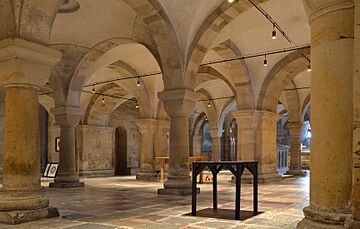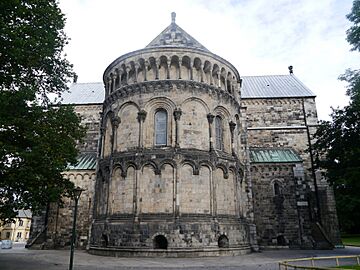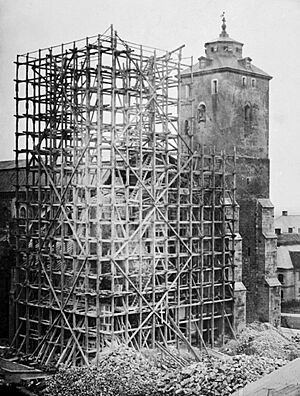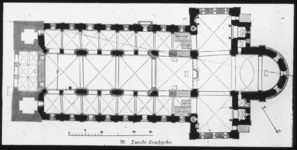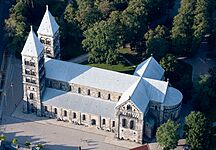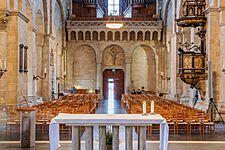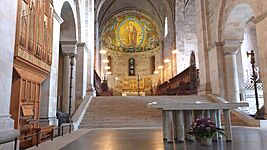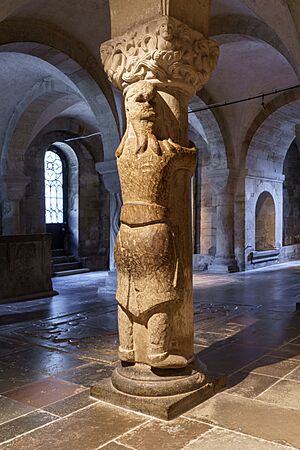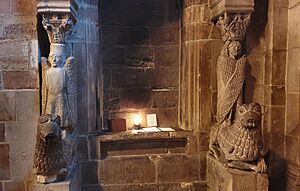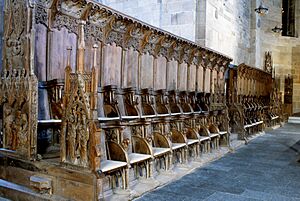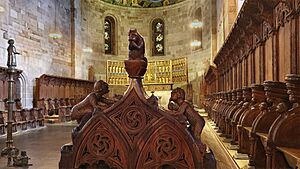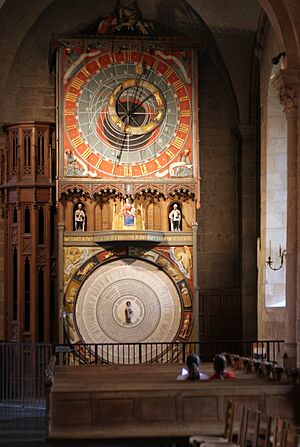Lund Cathedral facts for kids
Quick facts for kids Lund Cathedral |
|
|---|---|
| Lunds domkyrka | |
 |
|
| 55°42′15″N 13°11′36″E / 55.70417°N 13.19333°E | |
| Location | Lund |
| Country | Sweden |
| Denomination | Church of Sweden |
| Previous denomination | Church of Denmark (until 1658) Roman Catholic (until the Reformation) |
| Website | Website of the Cathedral |
| History | |
| Status | Cathedral |
| Founded | Late 11th century |
| Dedication | Saint Lawrence |
| Consecrated | 30 June 1123 (crypt) 1 September 1145 (main altar) |
| Architecture | |
| Functional status | Active |
| Heritage designation | Ecclesiastical monument in the buildings database of the Swedish National Heritage Board. |
| Architect(s) | Donatus Adam van Düren Carl Georg Brunius Helgo Zettervall |
| Style | Romanesque Neo-Romanesque |
| Specifications | |
| Length | 85 m (279 ft) |
| Width | 30 m (98 ft) |
| Height | 55 m (180 ft) (to the top of the towers) |
| Administration | |
| Diocese | Lund |
Lund Cathedral (in Swedish: Lunds domkyrka) is a grand Lutheran church in the city of Lund, Sweden. It is the main church for the Diocese of Lund. For hundreds of years, it was a Catholic cathedral for all the Nordic countries and was dedicated to Saint Lawrence. It is one of the oldest stone buildings in Sweden that is still used today.
The cathedral is a famous example of Romanesque architecture in Northern Europe. When it was built, Lund was part of Denmark. The main altar was blessed in 1145, and most of the church was finished by then. Its design was inspired by churches in northern Italy. The first known architect was named Donatus.
The cathedral has amazing stone carvings, including two famous statues in the crypt known as "The giant Finn and his wife". A local legend tells a story about them. The church was badly damaged by a fire in 1234. In the 1500s, a builder named Adam van Düren led major repairs. After the Reformation, when the church became Lutheran, it lost money and fell into disrepair.
In 1658, Lund became part of Sweden. During the 1800s, architects Carl Georg Brunius and Helgo Zettervall led a huge restoration project. Zettervall even tore down the old western towers and rebuilt them in a new style. Today, the cathedral holds many historic treasures, including a beautiful altarpiece from 1398, an amazing astronomical clock, and a large mosaic in the apse.
History of the Cathedral
How the Cathedral Was Built
Before this cathedral, other churches stood in Lund. But in the 11th century, Lund became a very important religious city. It was made the center of the church for all the Nordic countries. This likely led to the decision to build a large, impressive cathedral.
The oldest part of the cathedral is the large crypt underneath the main floor. The crypt's main altar was blessed and ready for use on June 30, 1123. The main altar in the upper church was dedicated to Saint Mary and Saint Lawrence on September 1, 1145. By this time, the cathedral was mostly complete.
The first architect we know by name was Donatus. He may have designed the crypt and the main part of the church. The style of the building was influenced by churches in Lombardy, a region in Italy. This style likely came to Sweden through Germany. Speyer Cathedral in Germany looks very similar to Lund Cathedral.
Building such a huge church required many skilled workers. It became a training center for local craftsmen, who learned new building and carving techniques from Europe. These skills then spread to other new churches being built across Scandinavia.
Fire, Repairs, and Big Changes
In 1234, a huge fire badly damaged the cathedral. The wooden roof burned and was replaced with stone vaults. Over the next few centuries, the church was repaired and changed many times. Buttresses, which are large stone supports, were added to the outside walls to keep them from collapsing under the weight of the new vaults.
Between about 1507 and 1524, the German builder Adam van Düren made important repairs. He fixed the drainage system in the crypt, rebuilt parts of the roof, and added larger windows. His work was so important that it may have saved the cathedral from falling down.
After the Reformation in the 1500s, the cathedral lost a lot of its income. It also suffered damage during wars between Denmark and Sweden. By the 1600s, the church was in very poor condition.
The Great Restoration
By the early 1800s, the cathedral was in desperate need of a complete renovation. The work began in 1832, first led by Carl Georg Brunius. He repaired the crypt, improved the drainage, and fixed parts of the exterior walls.
In 1860, a younger architect named Helgo Zettervall took over. Zettervall had big ideas for the cathedral. He wanted to make it look like a perfect, unified Romanesque building. Over several decades, he made massive changes.
Zettervall's work was dramatic. He removed all the old buttresses. He completely demolished the western front of the church, including the medieval towers, and rebuilt them according to his own designs. This is why the towers look newer than the rest of the building. The restoration was finally finished in 1893.
In the 20th century, more work was done. A beautiful mosaic by artist Joakim Skovgaard was added to the apse in 1927. The church was also restored between 1954 and 1963.
Architecture and Art
Lund Cathedral is a powerful example of Romanesque architecture. It has two tall towers at the west end. Inside, a long central hall called the nave leads to a cross-shaped area called the transept. A short flight of stairs leads up to the choir and the semi-circular end of the church, called the apse.
The apse is the best-preserved part of the original Romanesque building. It has three levels of beautiful arches and columns. The main building material is sandstone from nearby quarries. The walls are very thick, between 2 and 3 meters (about 6 to 10 feet).
- Overview of Lund Cathedral
Amazing Stone Sculptures
The cathedral is famous for its stone sculptures. The most well-known are in the crypt. They are two figures traditionally called "The giant Finn and his wife". A local legend says that a giant named Finn helped build the church. When he wasn't paid, he tried to destroy it by shaking the pillars but was turned to stone.
Most experts today think the larger figure is actually the biblical hero Samson. The sculptures were carved when the crypt was built and are very famous.
The church is filled with other beautiful carvings. Many of the columns have detailed capitals, some with designs inspired by Classical art and others by Byzantine art. There are also later sculptures made by Adam van Düren in the 1500s, including carvings of animals.
Historic Furnishings
The Main Altarpiece
The main altarpiece is a stunning work of art given to the cathedral in 1398. It was made in a workshop in northern Germany. The center panel shows the Coronation of the Virgin Mary, surrounded by 40 statues of saints. It is very large, measuring 7.6 meters (about 25 feet) wide.
The Choir Stalls
The choir has 78 seats made from oak wood in the late 1300s. These stalls are about 3 meters (10 feet) tall and are covered in detailed carvings. The carvings show scenes from the Bible. They are some of the best examples of Gothic wood sculpture in the Nordic countries.
The Astronomical Clock
A wonderful astronomical clock, called Horologium mirabile Lundense, is located in the north aisle. It was first installed around 1425. After being taken down in 1837, it was restored and put back in place in 1923.
Twice a day, the clock comes to life. It plays the song In dulci jubilo as two knights on top clash their swords. Then, a parade of small figures representing the Three Kings and their servants moves across the clock's face. The top part of the clock shows the time and the stars, while the bottom part is a calendar.
The Pulpit
The pulpit, where the priest gives sermons, was made in 1592. It is made of sandstone, marble, and limestone. It is attached to one of the main pillars of the nave. The sides are decorated with alabaster carvings showing scenes from the New Testament.
The Cathedral Today
Connection to Lund University
The cathedral has a strong link to Lund University. When the university was founded in 1666, the opening ceremony was held in the cathedral. For a long time, parts of the church were even used as classrooms and as a library. Today, the university still holds its graduation ceremonies for new doctors (PhDs) in the cathedral.
Music at the Cathedral
Music is a big part of life at the cathedral. It has several choirs for both children and adults. The church is also a popular place for concerts.
Lund Cathedral has six church organs. The main gallery organ is the largest in Sweden. It was built between 1932 and 1934 and has over 7,000 pipes. It creates a powerful and beautiful sound that fills the historic church.
See also
 In Spanish: Catedral de Lund para niños
In Spanish: Catedral de Lund para niños


